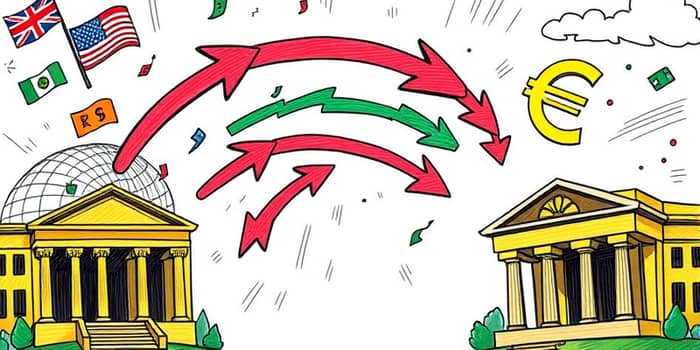
In an increasingly interconnected financial world, the gap between monetary policies of major central banks has become a powerful driver of capital flows. As long-term investors and speculators chase higher yields, interest rate differentials spur significant cross-border movements of funds. This article explores the mechanics of this phenomenon, its impact on emerging markets, and the policy responses aimed at mitigating destabilizing outflows.
Monetary policy divergence occurs when central banks pursue opposing stances—some tightening by raising rates, others easing or holding steady. Since 2021, the Federal Reserve has gradually increased its policy rate above 1.75%, while the European Central Bank (ECB) and Bank of Japan (BoJ) maintain rates near zero or even negative territory.
This gap in yield attracts global investors, leading to sustained capital inflows into the U.S. and other tightening economies, and outflows from regions offering lower returns.
At the core of cross-border fund movements lies the principle of arbitrage: investors redeploy capital to maximize risk-adjusted returns. When U.S. rates rise, U.S. Treasury yields become more attractive relative to sovereign debt elsewhere.
Simultaneously, risk perception and spillovers play a critical role. Gauged by measures such as the VIX and emerging market bond indices, heightened risk aversion prompts a flight to perceived safety. Emerging market (EM) assets suffer as portfolios shift toward advanced economies.
Emerging markets often face the brunt of global monetary divergence. Large capital outflows can trigger capital outflows increase exchange rate volatility, raise domestic borrowing costs, and undermine growth prospects.
When local central banks respond by hiking rates, their efforts may be overwhelmed by global sentiment. Between 1996 and 2018, EM economies experienced sharper credit spread widening during U.S. rate-hike cycles, leading to slower domestic credit growth and economic contraction.
Historical episodes underline this vulnerability:
Policymakers in EMs face a delicate balancing act. A flexible exchange rate can absorb some shocks, but currency depreciation pressures may fuel inflation and social discontent.
Common responses include:
Yet, these measures can only partially offset the influence of global funding conditions. Calls for synchronized monetary policy have become more vocal, urging central banks to consider cross-border spillovers when setting domestic rates.
Empirical research from 1996:Q1 to 2018:Q4 across 46 EMEs and 13 advanced economies reveals that policy rate differentials explain a significant portion of net capital flows. Regression analyses show that failure to account for domestic monetary responses underestimates outflow sensitivity by up to 50% in fixed-rate regimes.
Consider the following snapshot of policy rates:
During periods of elevated volatility (e.g., VIX spikes), EM capital outflows accelerate, confirming the interaction between rate gaps and risk sentiment.
Monetary policy divergence not only reshapes capital flows but also exacerbates global imbalances. Advanced economies accumulate surpluses, while deficit regions grapple with higher funding costs and debt service burdens.
Developing nations often face rising hard-currency debt obligations, risking sovereign distress if outflows persist. The uneven recovery paths from the global recession further complicate coordination efforts.
International forums, including the IMF and G20, increasingly debate mechanisms for coordinated policy interventions to mitigate spillovers while respecting each economy’s unique conditions.
As major central banks diverge in their monetary stances, the resulting capital flows carry profound implications for growth, stability, and global financial integration. While emerging markets strive to weather the storm, the need for enhanced cross-border cooperation and adaptable policy frameworks has never been clearer. Understanding the mechanics and consequences of monetary policy divergence is crucial for investors and policymakers alike as they navigate an era of shifting economic tides.













